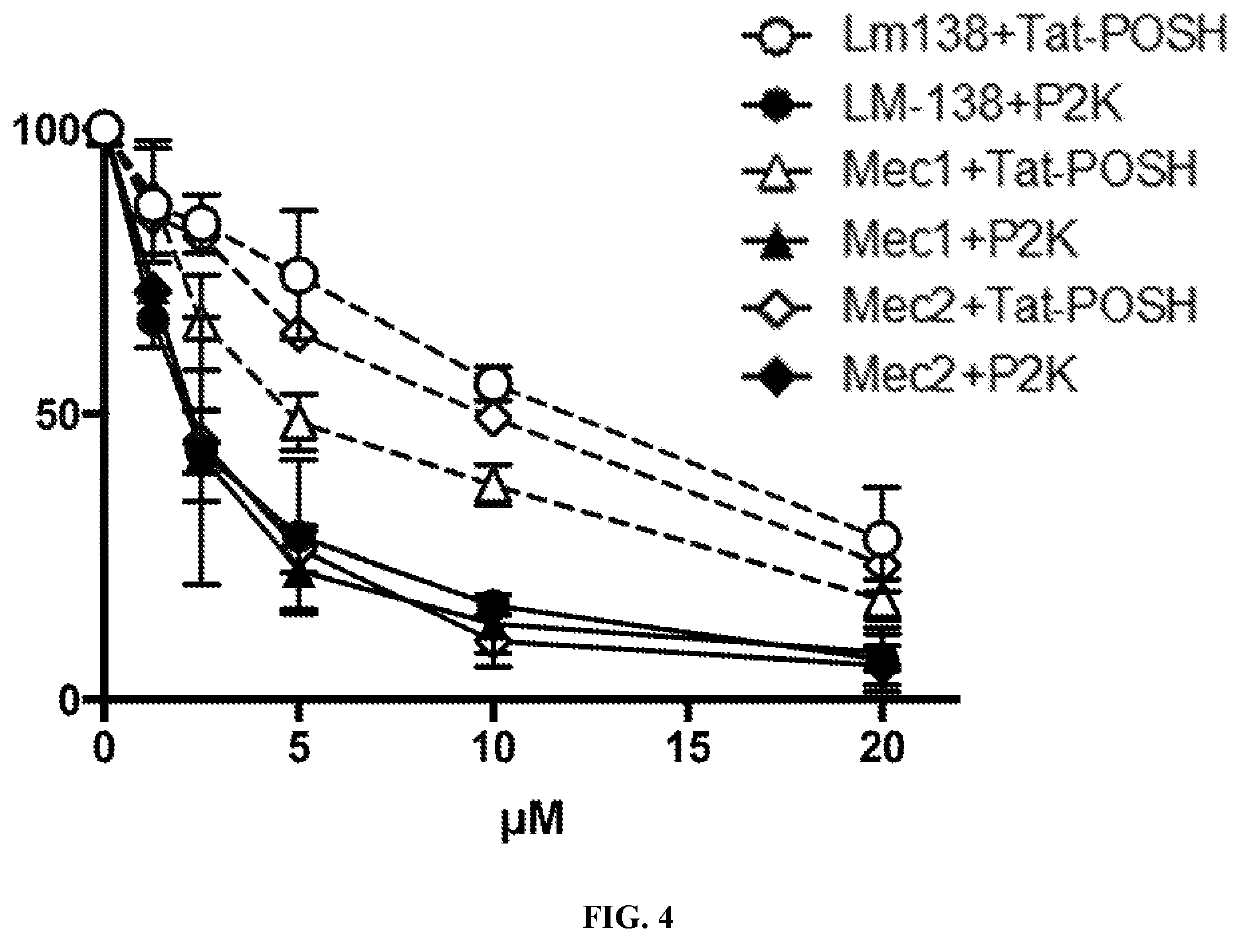POSH inhibitor complex biomolecules and amphiphile micelles
a technology of amphiphile micelles and complex biomolecules, which is applied in the field of anticancer drugs, can solve the problems of poor prognosis, high risk of patients, and poor prognosis of all patients
- Summary
- Abstract
- Description
- Claims
- Application Information
AI Technical Summary
Benefits of technology
Problems solved by technology
Method used
Image
Examples
example 1
[0050]POSH, TAT-POSH, and POSH-KKP2 Synthesis
[0051]POSH and TAT-POSH peptides were synthesized by Fmoc solid phase synthesis and purified by high pressure liquid chromatography. An ε-lysyllysine residue was added to the C-terminus of POSH through which two hydrophobic aliphatic palmitic acid moieties were conjugated, yielding the amphiphile POSH-KKP2.
[0052]Micelle Formation and Characterization
[0053]POSH-KKP2 was solubilized in water and micelle formation and morphology were assessed by previously established characterization techniques. The capacity for POSH-KKP2 to self-assemble into micelles was evaluated by a critical micelle concentration (CMC) assay where 1,6-diphenylthexatriene greatly increases in fluorescence intensity when trapped within the micelle core. POSH-KKP2 amphiphiles readily formed micelles as indicated by a very low CMC of 0.18 μM as shown in FIG. 2.
[0054]Transition electron microscopy (TEM) revealed that POSH-KKP2 self-assembled into micelles (FIG. 3) of which ...
example 2
[0058]The results of Example 1 are consistent with results generated with human B cell leukemia Mec-1 and Mec-2 cells as discussed herein. When peptide amphiphiles comprised of hydrophilic CD19-aptamer-Tat-POSH peptide and a hydrophobic moiety were exposed to water they self-assembled into spherical or cylindrical micelles by hiding their hydrophobic moieties in their core and displaying their hydrophilic aptamer-peptides on their surface. As shown in FIG. 3, an electron micrograph of the POSH-KKP2 micelles confirmed their spherical shape. 2× serial dilutions of POSH-KKP2 micelles (20 μM starting concentration) were incubated with murine Bcr / Abl+ BCP-ALL LM138, Human B-CLL Mec1 and Mec2 cells for 24 hours in vitro. Percent survival was measured by flow cytometry (7AAD, active caspase-3). Curves (n=3 for each) were analyzed by non-linear regression. F test analyses of Tat-POSH vs. of POSH-KKP2. p<0.001 (Prism by GraphPad). The results are shown in FIG. 4 (P2K means POSH-KKP2).
[0059]F...
PUM
| Property | Measurement | Unit |
|---|---|---|
| survival time | aaaaa | aaaaa |
| survival time | aaaaa | aaaaa |
| hydrophilic | aaaaa | aaaaa |
Abstract
Description
Claims
Application Information
 Login to View More
Login to View More - R&D
- Intellectual Property
- Life Sciences
- Materials
- Tech Scout
- Unparalleled Data Quality
- Higher Quality Content
- 60% Fewer Hallucinations
Browse by: Latest US Patents, China's latest patents, Technical Efficacy Thesaurus, Application Domain, Technology Topic, Popular Technical Reports.
© 2025 PatSnap. All rights reserved.Legal|Privacy policy|Modern Slavery Act Transparency Statement|Sitemap|About US| Contact US: help@patsnap.com


